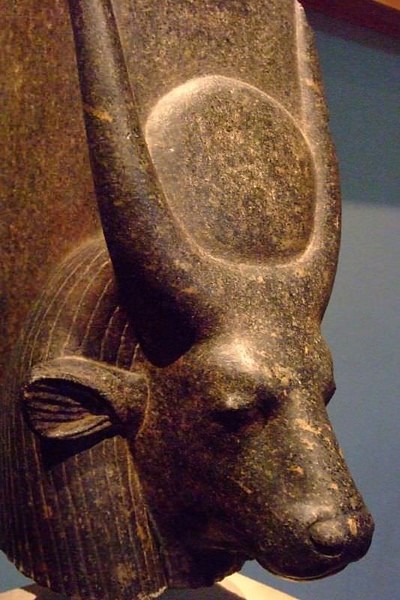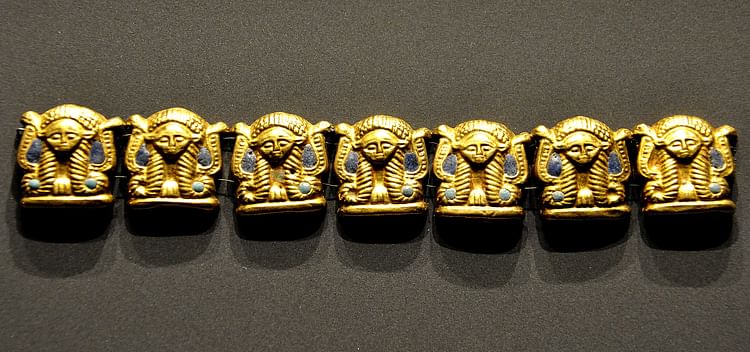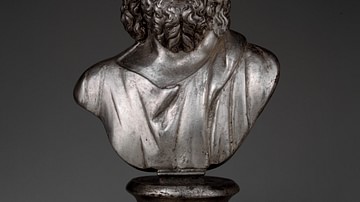
Hathor is an ancient Egyptian goddess associated, later, with Isis and, earlier, with Sekhmet but eventually was considered the primeval goddess from whom all others were derived. She is usually depicted as a woman with the head of a cow, ears of a cow, or simply in cow form.
In her form as Hesat she is shown as a pure white cow carrying a tray of food on her head as her udders flow with milk. She is closely associated with the primeval divine cow Mehet-Weret, a sky goddess whose name means "Great Flood" and who was thought to bring the inundation of the Nile River which fertilized the land.
Through this association, Hathor came to be regarded as the mother of the sun god Ra and held a prominent place in his barge as it sailed across the night sky, into the underworld, and rose again at dawn. Her name means "Domain of Horus" or "Temple of Horus" which alludes to two concepts. The first allusion is to the part of the sky where the king (or dead king) could be rejuvenated and continue rule (or live again) while the second is to the myth that Horus, as sun god, entered her mouth each night to rest and returned with the dawn. In both cases, her name has to do with re-birth, rejuvenation, inspiration, and light. Her relationship with the sky identified her with Venus, the evening and morning star.
The sistrum is her instrument which she used to drive evil from the land and inspire goodness. She is the patron goddess of joy, celebration, and love and was associated with Aphrodite by the Greeks and with Venus by the Romans. She was always, from the earliest times, associated with women and women's health in body and in mind. In time, women came to identify with Hathor in the afterlife the same way that, previously, all people identified with the god Osiris. She was an immensely popular and influential goddess. Scholar Geraldine Pinch comments on this, writing:
Hathor was the golden goddess who helped women to give birth, the dead to be reborn, and the cosmos to be renewed. This complex deity could function as the mother, consort, and daughter of the creator god. Many lesser goddesses came to be regarded as "names" of Hathor in her contrasting benevolent and destructive aspects. She was most commonly shown as a beautiful woman wearing a red solar disk between a pair of cow's horns. (137)
The red solar disk, as well as a number of Hathor's personal attributes, would come to be associated with the later goddess Isis. In time, Isis absorbed more and more of the characteristics of Hathor until she supplanted her as the most popular and widely worshipped in Egypt.
Mythical Origins
Although in time she came to be considered the ultimate personification of kindness and love, she was initially literally a blood-thirsty deity unleashed on mankind to punish humans for their sins. An ancient text, The Book of the Heavenly Cow (from the Middle Kingdom, 2040-1782 BCE), similar to that of the biblical flood, tells of the great god Ra becoming enraged at human ingratitude and evil and releasing Hathor upon humanity to destroy them. Hathor descends on the world in a fury of destruction, killing everyone she finds and toppling their cities, crushing their homes and tearing up fields and gardens and so transforms into the goddess Sekhmet.
At first, Ra is pleased because humanity had forgotten him and the gifts of the gods and had turned to only thinking of themselves and following after their own pleasure. He watches Sekhmet's swath of destruction with satisfaction until the other gods intervene and ask him to show mercy. They point out that Sekhmet is going too far in teaching this "lesson" to humanity and how, soon, there will be no human beings left on earth to benefit from it.
Ra regrets his decision and devises a plan to stop Sekhmet's blood lust. He orders Tenenet, the Egyptian goddess of beer, to brew a particularly strong batch and then has the beer dyed red and delivered to Dendera. Sekhmet, by this time, is crazed with the thirst for more blood and, when she comes upon the blood-red beer, she quickly seizes it and begins drinking.
She becomes drunk, falls asleep, and wakes up as Hathor the benevolent. Humanity was spared destruction and their former tormentor became their greatest benefactress. Following her transformation, Hathor bestowed only beautiful and uplifting gifts on the children of the earth and assumed such high status that all the later goddesses of Egypt can be considered forms of Hathor. She was the primordial Mother Goddess, ruler of the sky, the sun, the moon, agriculture, fertility, the east, the west, moisture and childbirth. Further, she was associated with joy, music, love, motherhood, dance, drunkeness and, above all, gratitude.
Worship of Hathor
Unlike other deities of ancient Egypt, whose clergy needed to be of the same sex as the deity they served, those who served Hathor could be men or women. Hathor's cult center was at Dendera but she was widely regarded and worshipped throughout Egypt to the extent that she was also honored as a goddess of the afterlife in The Field of Reeds.
Originally, when one died in ancient Egypt, whether male or female, one assumed the likeness of Osiris (lord and judge of the dead) and was blessed by his qualities of moral integrity. So popular was Hathor, however, that, in time, the female dead who were deemed worthy to cross intothe paradise of The Field of Reeds assumed Hathor's likeness and qualities while the male dead continued to be associated with Osiris. Geraldine Pinch writes:
The Coffin Texts and the Book of the Dead have spells to help the deceased live forever as a follower of Hathor. In a Late Period story, Hathor rules the underworld, emerging to punish those who behave unjustly on earth. By the Greco-Roman period, dead women in the afterlife identified themselves with Hathor instead of Osiris. It was only after Isis took over many of her attributes that Hathor lost her place as the most important of Egyptian goddesses. (139)
Hathor's popularity is attested to by the number of minor goddesses who shared her attributes and were considered aspects of the Mother Goddess. The most important of these were the Seven Hathors who were present at the birth of a human being and decreed their fate. Hathor was, in early times, worshipped in the form of a cow or as a cow with stars above her. Later she was pictured as a woman with the head of a cow and, later still, as a woman complete with a human face but sometimes with the ears or horns of a cow.
The Seven Hathors shared these attributes but also had a red ribbon which they used to bind evil forces and dark demons. The Seven Hathors were venerated highly in life for their ability to assist in matters of love and protection from harm and, after death, for their protective abilities against the forces of darkness.
As a goddess who transcended life and death, Hathor was widely worshipped and came to be idenified with a deity known as The Distant Goddess. This is a goddess who abandons her father Ra and assumes the form of a wild feline to elude any attempts to find her or catch her. She vanishes into the distant desert and hides in the arid plains. This goddess was linked with transformation and was identified with Mehit, a protective goddess, with Sekhmet, Bastet, Mut, and others but quite often with Hathor as in The Book of the Heavenly Cow in which Hathor herself is transformed as well as the universe and humanity's relationship with the gods.
When the Distant Goddess eludes Ra's control, a god is sent forth by Ra to find his daughter and bring her home and, when this happens, she brings with her the inundation of the Nile River which overflowed its banks and brought life to the people. Before she released the life-giving waters, however, she had to be placated and shown appreciation. Geraldine Pinch writes:
When the Distant Goddess returned, she brought the inundation with her, but she had to be pacified with music, dancing, feasting, and drunkenness. This was the mythical justification for the wild, ecstatic elements in Hathor's cult. It was proper for the whole of creation to rejoice when Hathor appeared again in all her radiant beauty and joined forces with her father. (138)
Pinch notes that this union of Hathor and her creator-father "could be thought of in sexual terms or, more abstractly, as a merging of the creator with his own active power" (138). An example of this is the role Hathor plays in one of the versions of the story of The Contendings of Horus and Set which continues the tale of the Osiris Myth.
Hathor and The Osiris Myth
After Set murdered Osiris and then hacked him into pieces, he scattered the body parts all across the land and flung some into the Nile. Isis gathered all the parts of her husband back together with the help of her sister Nephthys and brought Osiris back to life but he was incomplete because a fish had eaten his penis and it could not be restored. Isis then transformed herself into a kite (a falcon) and flew around Osiris' body, drawing his seed into her and becoming pregnant with Horus. Osiris then descended into the underworld to become Lord of the Dead while Isis was left alone to raise her son and Set usurped Osiris' place as king of the land.
Isis hid Horus from Set until the boy was grown; at which point Horus challenged Set for rule of the land. This struggle is sometimes represented as a battle but, in the story known as The Contendings of Horus and Set, it is a trial overseen by the Ennead, a tribunal of nine powerful gods, who are to decide who is rightful king. Chief among these gods is Hathor's father Ra who, at one point becomes so upset with the proceedings, he refuses to participate. Geraldine Pinch relates the rest of the story:
Ra becomes angry when he is insulted by the baboon god Babi and lies down on his back. This implies that the creator sun god was sinking back into the inert state that would mean the end of the world. Hathor, Lady of the Southern Sycamore, visits her father and shows him her genitals. He immediately laughs, gets up, and goes back to administering justice. Hathor has aroused the sun god and driven away his evil mood. (138)
Although clearly a sexual gesture, the abstract interpretation is of the importance of balance between the feminine and the masculine principles in maintaining order and harmony. Hathor reveals herself to her father in an unexpected gesture which lightens his mood and puts things in perspective. The balance between the duality of feminine and the masculine, between light and dark, fertility and aridity is emphasized throughout Egyptian culture in the gods and the myths relating to them.
Hathor and the Eye of Ra
This balance is seen in the concept of the Eye of Ra, the female conterpart to the male aspect of creation embodied in Ra. The Eye of Ra, like the Distant Goddess, was associated with a number of female deities but, again, often Hathor. Geraldine Pinch notes that "the ancient Egyptian word for eye (irt) sounded like a word for "doing" or "acting". This may be why the eyes of a deity are associated with divine power at its most interventional. Since the word irt was feminine in gender, divine eyes were personified as goddesses" (128). The Distant Goddess story is actually an Eye of Ra story in that the feminine aspect of the divine goes forth, acts upon its environment, and returns to bring transformation. This is clearly evident in The Book of the Heavenly Cow in which Hathor is identified as the Eye of Ra who will bring destruction to humanity but eventually transforms their relationship with the divine.
This same pattern is seen in the creation tale featuring Atum (Ra) and the ben-ben when he sends his children out with his eye to create the world. Hathor was often referred to as "The Eye of Ra" or "The Eye of Atum" and her sun disk is often represented as an eye from which the sun is born. In the story of the sun god's voyage through the night sky and the underworld, Hathor stands in the prow keeping watch for any sign of danger from Apophis. Throughout Egyptian history she was known as the daughter of Nut and Ra, Wife of Ra, mother of gods, and great Mother Goddess (perhaps related to the even older goddess Neith) so it is no surprise that popular stories such as the Distant Goddess or concepts like the Eye of Ra would tend to feature her.
Some ancient stories depict her as the mother of Horus the Elder and others as the wife of Horus of Edfu, resulting in the birth of Horus the Younger who was later regarded as the son of Osiris and Isis. Hathor's early identification as the mother of Horus, the god most closely associated with the ruler of Egypt, attests clearly to her importance prior to the rise in popularity of the Myth of Osiris when Isis became Horus' mother. Hathor was worshipped in every region of Egypt before the ascent of Isis and her cult was popular with both the poor working class of Egypt and the ruling elite.
The Five Gifts of Hathor
A part of the initiation into her cult appears to have been a ritual known as The Five Gifts of Hathor, a poorly attested rite possibly from the period of the New Kingdom, in which a communicant would be asked to name the five things they were most grateful for while looking at the fingers of their left hand. As the poor of Egypt did not own their own land, but labored for others in the fields, their left hand was always visible to them as they reached out to harvest grain which would then be cut by the blade in their right hand.
By naming the five things one was grateful for, and identifying them with the fingers of the left hand, one was constantly reminded of the good things in one's life and this kept one from the `gateway sin' of ingratitude from which, it was thought, all other sins followed. For the more affluent of Egypt, considering the Five Gifts would have been a way to keep from envying those more prosperous than oneself and a means by which one was reminded to be humble in the face of the gods. This humility would show itself by one's service to others. Scholar Margaret Bunson comments on this:
In the Daily Royal Rites, as shown on temple reliefs, Hathor nursed the king or his priestly representative from her breasts, thus giving him the grace of office and the supernatural powers to protect Egypt. (107)
She served the king and his court as nurse and, by doing so, fed all the people of Egypt as the prosperity of the land was intimately tied to the health, well-being, and stability of the king. If a goddess of Hathor's stature could freely serve others, it was thought, so could anyone else. Hathor continued this service to humanity after death as Geraldine Pinch notes:
As the goddess of the West, Hathor welcomes the setting sun into her outstretched arms. For both gods and people, Hathor eased the transition from death to new life. The time and manner of a person's death was decreed by a sevenfold form of Hathor. As Lady of the Necropolis, she opened the gates of the underworld. As a tree goddess, she revived the newly dead with shade, air, water, and food. The spirits of the dead could imbibe eternal life from the milk of the seven Hathor cows. (138-139)
Hathor's humble service is depicted through inscriptions and texts throughout Egypt's history from the Early Dynastic Period (c. 3150-2613 BCE) through the last dynasty to rule Egypt, the Ptolemaic Dynasty (323-30 BCE). In her earthly form as a dairy cow, Hathor was known as Hesat, the wet-nurse to the gods, and is always associated with motherhood, motherly instincts, and the care of others. Milk was known as `The beer of Hesat' and The Milky Way as seen in the night sky also came to be associated with her as it was considered a heavenly Nile River, the giver and sustainer of all life. As mistress of song and dance, of celebration and gratitude, bringer of life and comforter in death, Hathor embodied the heavenly Nile in all ways as she brought the best gifts of the gods to the people of earth.









